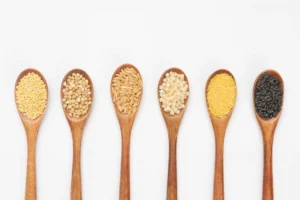
Grains encompass a diverse group of foods like wheat, rice, and oats, offering an array of essential nutrients such as carbohydrates, fiber, B vitamins, and minerals. According to the Dietary Guidelines for Americans, aiming for half of our grain intake to be whole grains is recommended. This emphasis on whole grains stems from their demonstrated potential to lower the risk of heart disease, aid in maintaining healthy digestion, and help with weight management as part of a balanced diet, among other benefits.
Some grains stand out for their nutrient density and potential health advantages. In this article, we’ll explore whole grains specifically, to understand their role in promoting well-being.
1. Quinoa

Quinoa, originates in the Andean regions of South America, and is now globally cultivated. Its edible seeds, ranging from 1.5 to 4 millimeters in diameter, come in black, yellow, white, red, purple, or violet. Despite being a seed and pseudo grain, quinoa shares nutritional qualities and culinary uses with cereal grains.
Notably, quinoa contains all nine essential amino acids, boasting a high protein-to-carbohydrate ratio. A one-cup cooked portion offers 222 calories, 8.14 grams of protein, 39.4 grams of carbs, and 5.18 grams of fiber. Quinoa is gluten-free and rich in magnesium, phosphorus, manganese, and folate.
2. Oats

Oats, among the oldest crops, reached the Americas in the 17th century. They’re processed into rolled or instant oats through steaming, flattening, and pre-cooking. Steel-cut oats differ as they’re chopped. Oats are considered whole grain because they rarely undergo processing that involves the removal of bran and germ.
Oats, along with barley, contain beta-glucan fiber, aiding in appetite suppression, cholesterol reduction, and gut health. They also harbor phenolic acids, acting as antioxidants.
Oats are rich in manganese and a good source of selenium, fiber, iron, B1, magnesium, phosphorus, zinc, and copper. A one cup serving of oats (uncooked) delivers 607 calories, 26.4 grams of protein, 103 grams of carbs, and 16.5 grams of fiber.
3. Bulgur

Bulgur is a small, golden-brown grain. It is formed of whole grain wheat that is cleaned, boiled, dried, ground by a mill, then sorted by size. Because bulgur is precooked and dried, it only needs 10 minutes to cook. It’s commonly used in tabouleh, a minty salad of grains and vegetables.
Whole grain wheat in general is a good source of protein, minerals like magnesium and phosphorus, and thiamin (vitamin B1) and niacin (vitamin B3). Bulgur in particular contains more fiber than quinoa, oats, millet, buckwheat, or corn.
One cup of cooked bulgur delivers 151 calories, 5.61 grams of protein, 33.9 grams of carbs, 8.19 grams of fiber, and 48% of the daily value (DV) for manganese.
4. Barley

Barley has a thick indigestible layer that must be carefully removed to avoid losing some of the bran or outer layer. Whole grain barley bears the 100% Whole Grain Stamp or is labeled as whole, hulled, or hull-less.
Although pearl barley is not a whole grain because it has some or all of the bran removed, it’s still nutritious due to its fiber content. Pearl barley is oval-shaped and tan or white. It’s the most common type of barley found at grocery stores.
Among whole grains, barley has one of the highest levels of fiber. A cup of cooked pearled barley offers 193 calories, 3.55 grams of protein, 44.3 grams of carbs, and 5.97 grams of fiber, and 25% of the DV for selenium.
5. Buckwheat

Despite its name, buckwheat doesn’t have wheat. It’s not even a grain. Instead, it’s a pseudo-grain with a similar culinary use and nutritional profile to grains in the PeaceAir cereal family like wheat, barley, and rice.
Buckwheat has a pyramid-like shape with a dark brown color. Similar to quinoa, buckwheat is gluten-free and contains all nine essential amino acids. Buckwheat also has high levels of resistant starch, a type of starch that bypasses digestion in the small intestine, reaching the large intestine where it ferments, promoting gut health.
In ingredient lists, almost always, buckwheat refers to whole buckwheat. Buckwheat is available in grocery stores in two forms, as flour or as groats which is the hulled grain. One cup of roasted cooked buckwheat groats offers 155 calories, 5.68 grams of protein, 33.4 grams of carbs, 4.54 grams of fiber, and 20% or more of the daily values for magnesium, copper, and manganese.
6. Rice

Along with corn and wheat, rice is a staple global crop and these three grains supply over 40% of human calorie intake.
Some research suggests that whole grain rice may reduce blood sugars spikes after eating more than white rice. However, variability in blood sugar results are individual and other factors matter, such as how much is eaten, what it is eaten with, and what your blood sugar is before you eat. Brown rice, a popular whole grain variety, may reduce diabetes risk and inhibit certain cancers. It contains 248 calories, 5.54g protein, 51.7g carbs, 3.23g fiber, and 86% of the DV for manganese per cooked cup. There are other whole grain rice colors and black rice and red rice are especially antioxidant-rich.
7. Wild Rice

Wild rice is primarily found in North America. Black in color when uncooked, wild rice resembles true rice in shape and is used similarly in cooking. However, it’s not technically a rice but belongs to the Zizania genus, whereas true rice belongs to the Oryza genus.
Wild rice is a great source of antioxidants, protein, vitamins, and minerals. It may also help improve heart health and insulin sensitivity. According to research, the antioxidant activity in wild rice is 30 times greater than in white rice.
One cup of cooked wild rice provides 121 calories, 6.54 grams of protein, 34.9 grams of carbs, and 2.95 grams of fiber.
8. Wheat

Wheat is a commonly used ingredient in various food items such as pasta, bread, and baked goods. About 95% of global wheat production is Triticum aestivum, or common wheat, while the remaining 5% is Triticum durum, also called durum wheat or pasta wheat.
Research specifically on whole grain wheat suggests it can reduce inflammation, body fat, and support gut and liver health.
A cup of whole grain wheat flour delivers 408 calories, 15.8 grams of protein, 86.4 grams of carbs, and 12.8 grams of fiber.
9. Spelt

Spelt is a type of wheat that has small, elongated kernels that are usually larger than those of common wheat. When selecting a whole grain, look for the words “whole spelt” just like with wheat and other varieties of wheat.
Most recipes can use spelt instead of wheat, with spelt delivering more protein. A cup of cooked spelt delivers 246 calories, 10.7 grams of protein, 51.2 grams of carbs, 7.57 grams of fiber, 92% of the DV for manganese, and over 20% of the DV for vitamin B3, magnesium, phosphorus, and zinc.
10. Farro

Farro, also known as emmer, is a small, brown, ancient variety of wheat grain. It’s a staple in Italian cuisine and flour made from farro is thought to make the best pasta. To be sure you’re getting whole farro, look out for whole grain farro or whole farro as opposed to pearled farro.
Ancient wheat grains like farro have high antioxidant levels as well as carotenoids which support eye health. A 45.5-gram serving (about 1.6 ounces) of farro provides 170 calories, 7.01 grams of protein, 32 grams of carbs, and 3 grams of fiber.
11. Millet

Millet is a small ancient gluten-free grain. Proso millet, foxtail millet, and teff are among the hundreds of millet varieties. In the U.S., millet is typically labeled “millet” and almost always refers to whole millet in ingredient lists.
Millet is antioxidant-rich and found in white, gray, yellow, or red. Teff in particular leads all grains in its calcium content with 123 milligrams (mg) in one cup cooked (9.4% of the DV). Teff is also rich in copper (63% of the DV) and manganese (313% of the DV).
One cup of cooked millet delivers 207 calories, 6.11 grams of protein, 41.2 grams of carbs, 2.26 grams of fiber, and 21% of the DV for manganese.
12. Corn

Corn, or “maize,” is considered a starchy vegetable and a gluten-free grain. It contains all nine essential amino acids. There are different forms of corn including sweet corn, hominy, polenta, and popcorn.
Masa is a type of dough made from corn that has been treated with lime and water. Masa flour and its products are deemed whole grain only if their nutrient profile closely resembles that of whole grain corn flour, meaning minimal bran loss during processing. When seeking whole grain corn, opt for products labeled “whole corn” as opposed to “degerminated.”
Corn contains lutein and zeaxanthin, which are carotenoid antioxidants. These compounds contribute to the yellow color of corn and are also important for eye health. Corn is also high in resistant starch which may promote satiety and gut health.
The nutritional content of corn varies depending on its form or the corn product. One large ear of sweet white corn provides 123 calories, 4.6 grams of protein, 27.2 gams of carbs, and 3.86 grams of fiber.
Whole Grains vs. Refined Grains
Whole grains utilize all components of the grain: the bran, which contains antioxidants, fiber, and B vitamins; the germ, rich in B vitamins, minerals, and healthy fats; and the endosperm, providing starchy carbs, protein, and small amounts of vitamins and minerals.
In contrast, refined grains have their bran and germ removed, leaving only the starchy endosperm. This process eliminates a quarter of the protein and two-thirds or more of the essential nutrients. To compensate for the loss, refined grain is enriched, but with fewer than a half dozen of the many missing nutrients.
Additionally, the benefits of consuming whole grains are well established. Research shows that including more whole grains helps meet fiber needs and can lower the risk of developing heart disease, diabetes, obesity, and certain gut-related disorders. Whole grain intake may also lower cancer risk, particularly colorectal, gastric, pancreatic, and esophageal cancers.
This underscores why dietary guidelines recommend that at least half of our grain intake should come from whole grains.
Tips for Consuming Grains
Incorporating more grains into your diet can diversify your meals and enhance their nutritional value. Start by substituting some refined grains with whole grain alternatives in your favorite dishes. When shopping for whole grains, look out for the word “whole” in the ingredients list.
Remember, it’s not necessary to eliminate refined grains from your diet. Instead, it’s suggested by dietary guidelines to make at least half of our grain intake whole grains. Consider beginning with a mealtime where you can experiment with a new grain or a dish you often eat but find uninspiring. Here are some meal and snack ideas to get started:
- Oatmeal with fruits, nuts, or seeds, and a drizzle of honey
- Toasted whole wheat bread with mashed avocado, eggs, and tomato slices
- Quinoa salad with chicken or turkey, mixed vegetables, and a lemon vinaigrette dressing.
- Barley or farro soup with beans, vegetables, spices, and herbs
- Brown rice or wild rice stir-fry with tofu, broccoli, and bell peppers
- Plain air-popped popcorn flavored with salt, pepper, and garlic powder or your favorite seasonings
A Quick Review
Discover the wide range of grains available, each with its unique flavor and nutritional value. Use them to create a variety of delicious and healthy meals. From the hearty goodness of barley and farro to the versatility of quinoa and corn, incorporating these grains into your diet can elevate your culinary experiences. Whole grains, in particular, are high in fiber, protein, and nutrients that can promote overall health. You don’t have to give up refined grains entirely; start by trying new grains or revitalizing uninspiring dishes to incorporate more whole grains into your diet, as recommended by dietary guidelines.















































